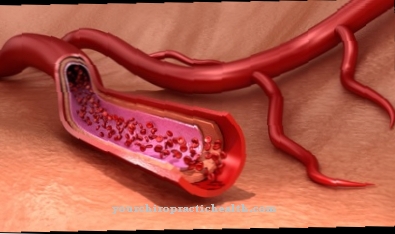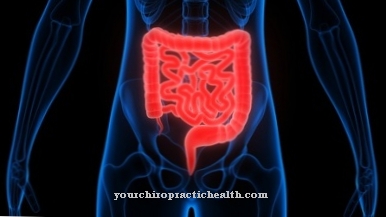The Air vessel function is a process that the arteries use to reduce the pressure differential between the systole and diastole of the heart. The effect helps maintain blood pressure and reduces stress on the heart. Atherosclerosis can make it difficult for the arteries to function properly or even take them away.
What is the air chamber function?

Arteries are elastic. This is especially true of the aorta. Because of their elasticity, arteries have what is known as the wind kettle function. The rhythmic contractions of the heart create a pulsating flow of blood. This pulsating blood flow is converted into a steady flow of volume within the arteries. This windkessel effect has consequences for the fluid mechanics within the human body and reduces the pressure difference between diastole and systole of the heart.
The fact that we are talking about an air tank effect in this context has to do with the different types of pumps used in the air tank. Pressure surges were absorbed into the rigid vessels by compressing an air bubble. The result was an even delivery of liquid. All arteries near the heart are based on the same principle, which explains the name.
Function & task
Arteries near the heart have a particularly high density of elastic fibers in their vascular walls. These elastic fibers allow the arteries to expand in a passive manner within the initial vessel segment. The blood volume can be stored in these areas for a short time. This creates potential energy. The efforts to retract the vessel walls convert this energy into mechanical energy. In this context, medicine understands retraction as the tendency to contract.
With the conversion of potential energy into mechanical energy, the further transport of blood through the vessel is guaranteed. The expansion and subsequent retraction of all subsequent sections of the artery are repeated as it is transported further. This creates an even, continuous flow of blood.
Due to this Windkessel effect, arteries are able to equalize pressure, which takes place on the basis of their elasticity. The aorta in particular benefits from the Windkessel effect. There is a large pressure difference between the contraction-related blood ejection phase of the heart and the relaxation phase of the heart muscle. The aorta can significantly minimize this pressure difference between systole and diastole through the Windkessel effect.
The volume of the aortic arch increases in this attempt. At the same time, the tension on the vessel walls increases as their diameter increases. Through these processes, the aorta stores a certain amount of energy from the work of the heart. After the aortic valve closes, the stored energy works against the resistance of the vessel as it flows out of the aortic arch and is ultimately converted into kinetic energy. As a consequence, the blood flow and the pulse strength harmonize after the brief storage of blood.
Originally there is pressure in the vicinity of the heart, but this pressure is relieved to a certain extent by the wind kettle effect. In this way the capillaries can deal with the residual pressure and the blood flow has an almost constant flow.
The heart of the Windkessel effect is thus the intermediate storage of blood. A young adult stores approximately half of his physiological stroke volume with approximately 40 milliliters. Only through this process of intermediate storage can the blood pressure be maintained. As a fluid-mechanical consequence of the Windkessel effect, the maximum volume flow rate drops. The minimum volume flow rate is increased at the same time. This results in a drop in the maximum pressure difference and, at the same time, an increase in relation to the minimum pressure difference.
Illnesses & ailments
In an age-physiological way, the function of the arteries in the air chamber decreases with increasing age. One reason for this is the remodeling work that takes place in the arterial wall with increasing age. The elastic fibers are gradually replaced by collagen fibers and the vessel walls lose their elasticity. In addition, arteriosclerotic deposits appear on the walls of the vessels with age.
The more the arteries lose their wind kettle function, the higher the column of blood, which the left heart has to accelerate, becomes. For this reason, the heart is exposed to greater stress in old age. Since the deposits in the vessels make a significant contribution to the decrease of the Windkessel effect, heart diseases are sometimes associated with diseases such as arteriosclerosis.
In arteriosclerosis, fat, thrombi, connective tissue and calcium are deposited within the blood vessels. In most cases, the disease is completely asymptomatic for years. Atherosclerotic plaques form in the area of the vessel walls during the first few years. This plaque formation narrows the lumina of the individual vessels piece by piece, until even occlusions appear. These occlusions result in a symptomatic functional restriction or even an infarction. Because of the increase in mechanical stress, arteriosclerosis can also lead to a tear in the vessel walls, which can be associated with hemorrhage and thrombus formation. Thrombi can be washed into other tissues and cause occlusions that lead to an insufficient supply of oxygen or tissue death.
Older people from the age of 80 usually always suffer from arteriosclerosis. However, an unhealthy lifestyle can cause arteriosclerosis to set in early. As the arteries lose their wind kettle function bit by bit as a result of the disease and this results in a high level of stress on the heart, the heart attack is one of the most relevant secondary diseases, along with a stroke. If you ban the risk factors for arteriosclerosis from your life, you will ultimately also prevent an early heart attack due to the lost air-conditioning function of the arteries.













.jpg)

.jpg)
.jpg)











.jpg)